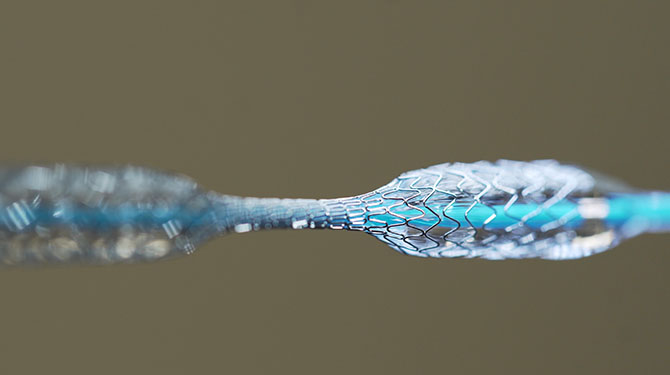
A stent is a small mesh tube made of either metal or fabric. Doctors use stents in conjunction with angioplasty to treat blocked or weak arteries.
During stent placement, an interventional radiologist inserts the stent into the affected artery with a balloon-tipped catheter. The stent stretches to keep the artery open or to strengthen it. The interventional radiologist performs the procedure using an angiogram for guidance.
You may benefit from stent placement if you:
- Have advanced atherosclerosis (buildup of plaque in your arteries) that isn’t improving with lifestyle changes and medicines
- Have a high risk for heart attack, stroke or gangrene due to atherosclerosis
- Have persistent chest pain (angina)
- Have a weakened aorta wall that puts you at risk for an aneurysm
- Have narrowing of a central vein, fistula or graft used for dialysis
- Had a heart attack and didn’t undergo thrombolysis immediately afterwards
Stent placement can take a few hours to complete. The length of the procedure depends on the number of arteries treated and location of the arteries. Most stent placements are performed under local anesthesia.
You can expect the following on the day of your procedure:
- Before the procedure begins, a nurse will give you a sedative to relieve any anxiety you may feel.
- The nurse will use a local anesthetic to numb the area where the interventional radiologist will insert the catheter – usually in the groin or arm.
- The interventional radiologist will make a small incision and insert the catheter through the incision and into an artery.
- He or she will then guide the catheter to the area being treated.
- Once the catheter is in place, the interventional radiologist will inject a contrast agent to create clear X-ray images of the affected artery – this is called an angiogram.
- The interventional radiologist will use the angiogram to guide the balloon-tipped catheter to the area being treated – the stent is wrapped around the balloon-tipped catheter.
- The interventional radiologist inflates the balloon to expand and place the stent.
- Once the stent is in place, the interventional radiologist will deflate the balloon, remove the catheter and close the incision.
You will stay in the hospital for one to three days to recover. You should arrange for someone to drive you to and from the procedure.
Upon your return home, you should avoid any strenuous activities for as long as your doctor recommends. Be sure to follow all of your physician’s orders for a proper recovery.
